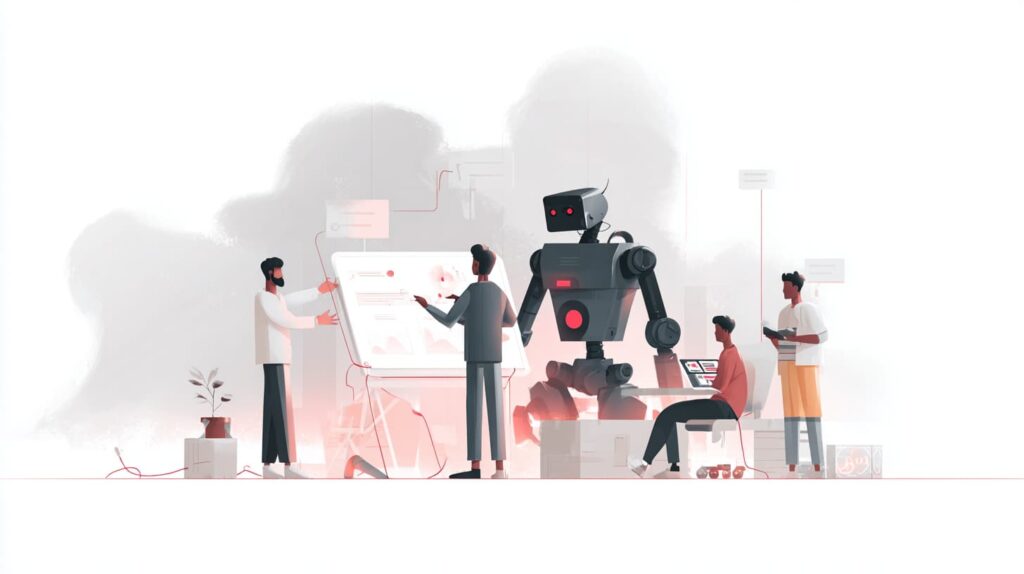By EloInsights
- Gabriel Renault, Chief Data & AI Officer at EloGroup, explains in an interview what digital transformation means today.
- He compares the current moment to the beginning of computerization and says that incorporating new digital technologies into business will be the new normal, even if it requires a profound cultural and paradigm shift.
- Renault talks about barriers, opportunities and offers tips for executives who want to expand their “digital intelligence”.
When explaining the timing and importance of digital transformation nowadays to organizations, Gabriel Renault, Chief Data & AI Officer at EloGroup, goes back to three decades ago, when the computerization was still crawling.
Back then, a company could boast of having computers or a department equipped with these machines, which were rare until then. Currently, regardless of the area in which they work, it is strange that no employee within a company does not have a computer to work with.
This same process will happen with the major “branches” of technology that make up an organization’s basic digital kit today. The new normal will include the implementation of analytics, big data, cloud, hyperautomation, blockchain, among others that help optimize operations, minimize costs and open windows of opportunity that would otherwise be unavailable.
But Renault insists that this is not just about technology, it is about culture and a paradigm shift. Technology needs to be a lens through which new ways of using it can be seen and explored. Although this, in turn, is impossible without deep structural change. Leadership upskilling, implementing elements of agility, investing in foundational technology, changing the management model and investing in talent capable of naturally incorporating the lens of new technologies are some of the key points for the digital transformation to take place in a complete and lasting way, not limited to a pilot or one-off MVP.
In this interview with EloInsights, Gabriel Renault also gives his view on the main barriers to a successful digital transformation, as well as giving tips for executives who want to expand their “digital intelligence”.
What does digital transformation mean? What does it encompass? What are the elements that assemble digital transformation for an organization today?
There is a more basic definition: digital transformation is the adoption of technology by a company. Other definitions go deeper: it is the process of using digital technologies to create new or change existing business processes, culture and customer experience to meet the market and business requirements of this new, ever-changing world. I like the second one better, because using and adopting technology has always been done. It has been done for a long time by IT in companies.
Why is there now this discussion of digital transformation? Because technologies are advancing in such a way that they become palatable, consumable, demandable and used by the lay user. We are living through a transition in which people no longer need a developer to deliver something technological. That is where all the low-code and no-code platforms come in. In analytics, which is something super-new and super-bold, there is already self-machine learning, which, for me, is going to be the new Excel.
At the beginning of computerization, people taught you what a computer was, how a mouse worked, etc. It was all very brand new, and you had to explain it. There was one department with a computer and another without. We are going through a second cycle of this at a time when more complex things, such as generating software and digital solutions, no longer need a technician or are not exclusively technical.
Alongside this is the Fourth Industrial Revolution, which the World Bank itself defines as big data plus IoT plus cloud plus artificial intelligence.
When we go to digital transformation literature, we add this to other technologies that are even newer and more complex. There are two major movements: more traditional digital, process and intelligence technologies, becoming accessible to the end user; and new disruptive technologies, changing industries in a structural way.
Besides the ones I have mentioned, we will also need to get into blockchain, computer vision, digital twins, technologies that have the capacity to reduce between 5% and 15% of the variable cost of a steel mill, for example. That is a lot of money on the table. In the digital transformation, we look through the lens of technology and opportunities start to be seen.
To summaries, digital transformation stands for absorbing and implementing new disruptive digital technologies with consistency to generate business results and change companies. It also means evolving their culture and allowing its end users to use the lens of technology to alter their own daily work. It is not just about technology; but a cultural and paradigm shift to enable the benefits of these technologies.
Is digital transformation more of a process with an end or something cyclical, constantly renewing itself? How does an organization ensure that this change happens?
I think the first obvious and very straightforward answer is: there is no end. It is not from point A to B. It is about achieving the goal of becoming strategically digital and being driven by change. The only certainty is that everything will change.
Various studies show that every 10 years or 5 years (the period varies) you will have to change careers. There will be no more graduating and retiring in the same career. In 10 years, you will have to find another one, because yours has probably changed so much that it is no longer the same.
Companies are going to experience this too; it has become part of our new reality. You are not going to make an effort now and stop. The structuring response that enables a company to do this is to change its culture. At EloGroup we use the book Technology Fallacy as a reference, which says that digital transformation is not about technology, it is about people and change.
A very important aspect is affordance. The concept comes from philosophy, but in technology it has taken on a specific use, which is to take a technology and use it in unforeseen ways. A silly example I always give is that I use WhatsApp with my wife to store files. It was not designed to store files, nor is it the best option. But it became practice for us. It is an unforeseen use of technology.
So, what is the difference when we talk about lenses? If you have a more naturally technological lens, you are going to use technology much better than if you do not. With much more potential. With much more potential.
Another example: it is one thing for me to use a mobile phone, another for my 7-year-old son, another for my 70-year-old mother. He explores the mobile phone in a way that I do not, and I am a technological guy. These are subtleties.
Bringing this to companies, there are new, digitally born companies that already use Slack almost like an ERP. Therefore, we see that it is about the lens, not the technology. It is about how they use it and how they exploit that potential. That is affordance.
Why do big techs keep closing the gap in performance and profitability? Why is this happening? Because most big tech employees have a technology lens. Blockchain is normal for them, they trade bitcoin and know how to use, on a daily basis, tools that arrived much later in a traditional company. With this knowledge, they go and disrupt the largest logistics company in the world.
The big change is cultural. Only by changing the culture can you structurally change to become strategically digital. Which, in a vision of digital transformation, never ends.
But how do we implement this in the company? In the end, you will have a new process, area and organizational chart. In my perspective, it is very similar to the start of computerization. Are you going to create a digital area? Given that you are going to become strategically digital and that this is going to become a constant, this is just the first stage because you need energy and focus to do it.
But that does not make sense by definition. So much so that all the frames, including ours, suggest making pilots, MVPs, break new ground. Show that there are opportunities, that you can break barriers, that you can innovate. Once you have done that, you start spreading the knowledge, the culture. Do the whole digital acculturation, digital literacy thing. Because, in the end, you want all areas to be digital, and not have digital separated out.
Your digital strategy must be aligned with the business strategy, it needs to be supportive, not disconnected.
So, all areas become digital in the company, because they now have a lens, and IT has been integrated, it is no longer isolated. It is IT by value stream. If I am talking about the sales team, I have someone from IT within sales, from artificial intelligence and these people are just thinking about it all day long.
Returning to the digital transformation that never ends, why does it not end? Firstly, there will always be gains to be made. Secondly, you want to spread it throughout the company. So, it is a curve that you are going to try to create and attract attention, but then it is going to become the new normal, like a computer.
What are the main capabilities that an organization needs to cultivate for this whole process to be successful and lasting?
There is a group of foundational competences without which you will not move or transform effectively. There are also those specific to each company and its culture, but, generally, you must master the whole world of IoT, artificial intelligence, customer experience, hyperautomation and blockchain. Perhaps you will not need all of them, but they are the most advanced technologies available in the market nowadays, so you need to have them in mind. Besides the cloud and big data, you are going to have to develop technical ability and take your average user – who, otherwise, had basic technological capacity – and bring them up to average. You must have that lens.
Along with this, there are the ways of working, methodologies, culture and management. In these matters, you will naturally end up falling into the agile culture – and EloGroup is not an advocate of agile for anything, but rather the agile mindset, especially the test and learn culture, and not being afraid of mistakes; being quick, correcting and giving autonomy. Everything that the agile culture brings is a great pillar and any company will have to have it. Not everything will be agile, but some things certainly will. It is much better and more effective for the parts that are innovative to run more on this model.
Also, you must have a culture of empowerment at the top. Transformation cannot be achieved if you are too hierarchical. So, there is an associated organizational structure discussion to deal with this.
Another thing: the company will have to develop a management model that encourages all of this. There is no point in wanting people to innovate, to have a culture of test and learn, if the moment someone says they are going to do an artificial intelligence project – which, by premises, success is not guaranteed – you punish that same person for not achieving satisfactory results. Or if your targets, with variable payment, only encourage certainty, the delivery of good results.
What are the main challenges you see companies facing during a digital transformation process? What are the biggest difficulties?
I think there are more general obstacles, such as culture and the fear of change. But, since the basis of the transformation will be the culture and the technological lens, this binomial, I think the challenges will vary greatly according to the level of maturity that each company has.
The first obstacle is being charged with short-term results. This confuses digital transformation with pilots, with a big project that makes a big name for itself and saves a lot of money. And not everyone is going to save that much. Or setting the bar too high or thinking that that is all you have done, and you have digitally transformed. So, focusing only on the short-term and on very quick projects is an obstacle.
How do you balance this with technological foundation projects? I think that is a big obstacle. And here comes a second point: ITs are very used to arguing for the technical world and they are experiencing this challenge now that the business areas are wanting to take part more.
For example, in a hypothetical situation, when you say that I need to create a data lake to do advanced analytics which will lead to an algorithm that gives a gain of R$300 million the business will not stand up and continue to make profit if you do not create the data lake. But the type of argumentation, awareness and level of intelligence or digital acculturation of average executives in Brazil is low.
This is another major obstacle, because it sets the tone and asks the wrong questions to assess what the digital transformation will look like. And then a project like this distorts their vision.
This technological foundation is a major barrier. Because these are large investments that take time to pay off. I must balance the long term and the short term; do MVPs, pilots, more one-off projects, but I need to get going with my foundation and my culture change.
The ability of the technical team is an obstacle in the war for talent. How do you attract developers, especially in the case of a “less attractive” company? Technical staff with a mindset for modern technologies is a bottleneck, it is very scarce. And then you cannot make this transformation if you do not have these people with this lens. You need these specialists.
Another thing is that there is no point in wanting to do this with the same structure, it needs to be more agile, without other stimuli. In other words, wanting to solve it with technology, without changing your organizational structure and operating model first.
What risks does an organization run by not pursuing its digital transformation?
I think the answer is very simple: it will disappear. The risk is that, by not doing so, it will become less and less efficient. If you do not have the lens of technology, you do not see this affordance, this other use of technology. And by so, you will not see the intrinsically dependent opportunities, the embedded opportunities.
In other words, it is only when I have taken a few steps in technology that I will see that I can optimize my production with precision, that I will gain 20% from optimization. I gained 20%; then, 10%; and another 15%. When I compare it to competitor X, I have a 50% lower cost. I left it behind me, because I am growing and expanding, gaining more investors, therefore, taking you out of the market.
I would give to executives in Brazil a three-year window to adapt. But this also varies from industry to industry. If we are talking about tourism, for example, anyone who has not done this is already dead! But traditional industries still have a little more time, maybe five years.
What does an organization gain from investing in this digital transformation process?
There are several figures to cite from recent research. Digital leaders have EBITDA five times higher than their competitors. The leaders, those who transformed earlier, have a cost – and this will vary from each industry – around 20% lower than their competitors. The market share is growing faster and the profitability per shareholder is higher. It is the results, no longer theory. This means having a better NPS [Net Promoter Score], a higher market share, profitability and revenue, as well as lower costs and expenses… it takes in everything. Apart from the intangible result of being prepared for the future, which is the generation of long-term value.
EloGroup talks a lot about the importance of integrating technology, analytics and management. In the context of digital transformation, how important is TAM?
Digital transformation is only possible with an effective TAM approach. Otherwise, you are just going to add technology; or just change the culture; or just bring in an artificial intelligence project. And these alone do not make a digital transformation. If one of these elements is zero, you will not have a transformation.
What suggestions would you give an executive for increasing their digital intelligence?
In all the executive forums I do, I ask: what have you read about transformation? Often the answer is “oh, my team is doing (…)”. But that is no good! You must stop to understand what is happening in your company and take part in the process!
Firstly, you got to take a pilot project to follow closely. This might be the best thing for you to do, even better than just studying the theory. Adults learn by getting their hands dirty! So, take an artificial intelligence, RPA, robotization or IoT pilot and follow the project, do a checkpoint – it can be fortnightly or weekly – so you can understand what is going on. I think that is a very objective tip.
Apart from that, there is a lot of good content on the internet – from online courses or quality published books. It is all about studying! Now, in practice, you need to, at least, follow the most relevant projects closely and understand the discussions. And not as an executive, but as someone who wants to understand what is going on. That is a great way to become acculturated.











